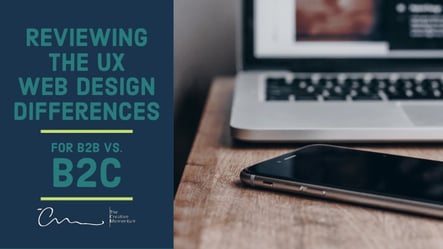
B2B and B2C marketing and web design strategies require different and deliberate approaches. UX web design varies between them to address issues specific to each use case.
How do web designers create UX solutions to address the differing strategies between B2B and B2C?
Emotions versus Planned Purchases
B2C purchases can be impulsive and oftentimes directed by emotional cues. Branding goes a long way to captivate consumers by inspiring the type of imagery, ideals, and feelings that trigger a purchase. Your UX design facilitates this with aesthetics, media, and novel interactivity. Visually striking sliders, slick CSS animations, and unique methods of engagement are a few examples. Quality UX design in B2C industries differentiates itself stylistically to make a brand shine.
B2B sales are rarely impulsive and are more likely driven by a known pain point in a workflow. Decisions are made carefully by doing a thorough analysis of the solutions available. Buyers compare companies and products, request demos and may receive a trial period to test the product. It can be a long sales funnel, but the wrong purchase is an expensive mistake.
The most critical thing to incorporate into a B2B marketing strategy is establishing trust with your buyer through demonstrated results and open information. This is important because when it comes to information, B2B buyers are going to want a lot of it. Exhaustive articles, white papers, webinars, and a host of other in-depth resources help inform business purchases in a valuable way. This means that your UX should make content delivery a top tier priority in your overall design. It isn’t enough just to have a blog or a few brochures lying around. Quality UX in B2B sales keeps a surplus of information within fingers reach for your buyer.
Additionally, if a software touts its ease-of-use, the website must be easy to use as well.
UX in the Buyer’s Journey
The journey from lead to conversion diverges significantly between B2B and B2C sales. In a nutshell, good B2C UX in e-commerce is streamlined. UX aimed at other businesses is thorough and attentive.
When buying consumer products or services, the buyer is looking to be done with their purchase with the least amount of hassle in the shortest period of time. Once they’ve initiated a purchase, your goal as a designer is to get them to checkout as soon as possible before they get distracted or change their mind. A lengthy checkout process, endless deals and promotions, or any other extraneous information and interaction can be detrimental to conversions.
B2B purchases are drastically different in this regard. The sales cycles are drawn out, thoroughly considered at every stage, and oftentimes involve multiple decision-makers. The majority of B2B purchases will also involve direct contact with a buyer. This last factor affects interactivity and CTAs. Live chat, email, and SMS are all viable engagement methods to incorporate into B2B UX design.
Target your Buyer Persona
B2B buyers are people just as much as consumers. Best practices, effective engagement, and breakthrough interactivity are all still viable approaches to UX design in either market segment. Many of the considerations that made Apple a technology giant are the type of design considerations typically concerned with consumer products. Ultimately, usability is still a core consideration in your UX design, regardless of who you’re targeting, and doing things differently can curry favor with any audience when it breaks the right type of ground.
When preparing to develop or launch your website, it’s always worth taking into account the specifics of your market segment. As it pertains to B2B vs B2C consumers considerations in purchase incentives and the buyer’s journey are valuable starting points. Beyond that, it’s worth taking into account the human element of B2B buyers and approaching with parallel design elements that work across the board.


